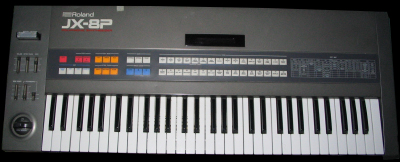- Roland JX-8P
Infobox_synthesizer

image_caption =
synth_name = JX-8P
synth_manufacturer = Roland
synthesis_type = Analog Subtractive
polyphony = 6 voices
timbrality =Monotimbral
oscillator = 2 DCOs per voice
filter = 1 resonant lowpass, 1 highpass
attenuator = 2 ADSR
lfo = 1 sine/square/sh
keyboard = 61 notes
ext_control =MIDI
memory = 64 preset patches/64 user patches
fx = Chorus
dates =1984 -1989
price = Approx. US$1695
keys = 61
velocity = Yes
aftertouch = Yes
split = NoThe Roland JX-8P was a 61-keyboard 6-note polyphonic
synthesizer released by Roland in 1984 to compete against theYamaha DX7 .Programmability
Programming was achieved either by means of a data slider and a silkscreened data table designating each of the parameters, or by means of a separate unit, the
PG-800 programming unit. ThePG-800 was a box with sliders and knobs for most of the parameters. The unit had to be acquired separately as it was not shipped with the synthesizer. While not difficult to change parameters, the effort of going through a number of parameters once at a time without hearing immediate sound changes created a discouragement for sound programming enthusiasts.It was possible to create monophonic sounds, using a set of
oscillator s (2 from a patch) or 6 at the same time (with the same patch) to create a 'denseness' effect in the patch.The built-in
chorus effect was switchable from off to two different modulation modes for every patch.Memory
Internal
Memory organization consisted in two internal blocks of 32 'patches', and a similar organization for the external cartridge. Patch memory could be dumped to
MIDI with a SYSEX message, with no "handshake" necessary. Initially, the owner's manual offered a programming sheet where parameters could be written on the blank lines. SYSEX memory dumps could be sent or recognized as "one patch" and "one bank". At the moment of receiving a memory dump, the synthesizer would keep all received patches in a memory buffer. In order to write the buffer to memory, the memory write lock had to be switched to "write" mode. The memory write lock was a physical switch in the back of the instrument and could be changed on the fly without the need of turning the instrument off for fear of damaging the memory (which was common on similar synthesizers).Cartridge
The
M-16C cartridge could store 32 more user patches, which could be loaded directly or transferred to the internal memory. The use was the same as the internal memory, including the protection switch.MIDI implementation
Artists using this instrument
*
Dzeltenie Pastnieki
*Europeee also
*
Roland JX-10 - A 12-voice 2-DCO synthesizer that was essentially two JX-8Ps put togetherExternal links
* [http://www.vintagesynth.com/roland/jx8p.shtml JX-8P at Vintage Synth Explorer]
Wikimedia Foundation. 2010.
